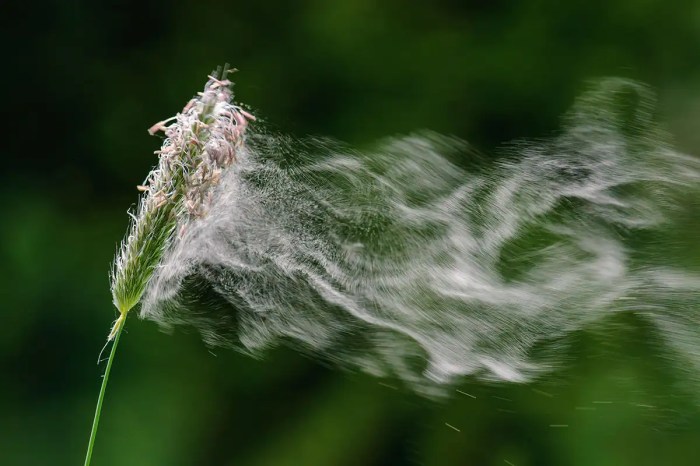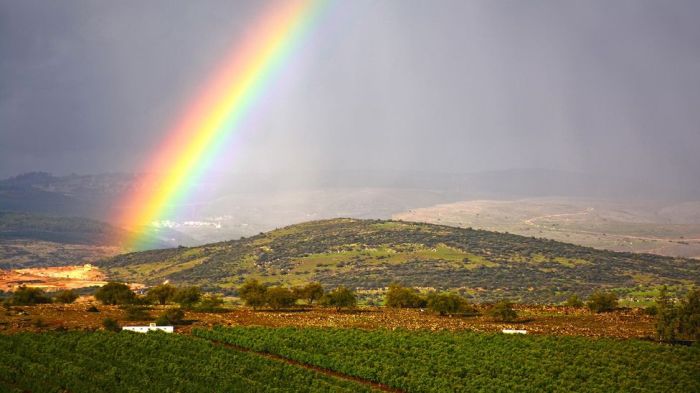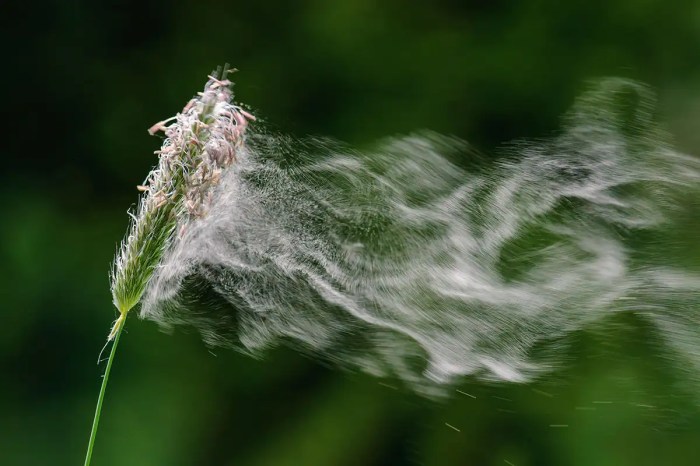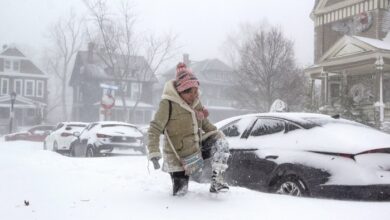
How climate change is making hay fever worse sets the stage for this enthralling narrative, offering readers a glimpse into a story that is rich in detail and brimming with originality from the outset. We’ll delve into the science behind the rising pollen counts, extended allergy seasons, and shifting pollen types, revealing how changing weather patterns are exacerbating this common affliction.
This is not just about sneezes and sniffles; it’s a story of how our planet’s health directly impacts our own.
From increased pollen production driven by warmer temperatures and altered rainfall patterns to longer allergy seasons, the impacts are significant. Different plant types are responding to climate change in various ways, leading to a complex interplay between environmental shifts and human health. The geographic distribution of these heightened pollen production patterns is also evolving, meaning that even those in areas not traditionally susceptible to hay fever are now facing challenges.
This increased exposure to allergens leads to more frequent and severe symptoms, affecting not only quality of life but also productivity and economic well-being.
Increased Pollen Production

Climate change is dramatically altering the environment, and one of the less-discussed but significant consequences is the intensification of hay fever symptoms. A key contributor to this worsening allergy is the escalating pollen production by various plant species. Understanding the mechanisms behind this increase is crucial to mitigating the impact of this growing health concern.Increased pollen production is a direct result of altered environmental conditions driven by climate change.
Warmer temperatures and altered precipitation patterns are significantly impacting plant physiology, leading to higher pollen output.
Mechanisms of Increased Pollen Production
Climate change influences plant growth and development through modifications in temperature and precipitation patterns. Warmer temperatures often lead to longer growing seasons, allowing plants more time to reproduce and produce pollen. Elevated carbon dioxide levels, a byproduct of increased greenhouse gas emissions, can also stimulate plant growth and pollen production. Changes in precipitation patterns, such as more intense rainfall events followed by droughts, can also affect the timing and quantity of pollen release.
These factors collectively contribute to a rise in pollen production, making hay fever seasons more severe and prolonged.
Examples of Heightened Pollen Production
Ragweed, a notorious pollen producer, is experiencing a dramatic increase in pollen output due to warmer temperatures and longer growing seasons. Studies have shown that ragweed pollen production has increased in many regions, particularly in the Midwest and East Coast of the United States. Similar trends are being observed in other plant species, including grasses, which are also significant pollen sources.
Impact on Hay Fever Seasons
The heightened pollen production is directly impacting the severity and duration of hay fever seasons. Longer growing seasons and increased pollen output lead to extended periods of high pollen counts in the air. This, in turn, exposes individuals to higher concentrations of allergens, causing more severe and prolonged allergy symptoms. The extended periods of pollen release make it harder for individuals to escape the effects of hay fever.
Geographic Distribution of Heightened Pollen Production
The heightened pollen production patterns are not uniform across the globe. Regions experiencing warmer temperatures and altered precipitation patterns are seeing more intense pollen seasons. For example, areas in the northern latitudes are experiencing longer and more intense pollen seasons as temperatures increase. These regions are seeing a shift in the typical pollen season, with the start and end of the season shifting towards earlier and later dates, respectively.
Pollen Counts Before and After Climate Change
| Region | Pre-Climate Change Average Pollen Count (per cubic meter of air) | Post-Climate Change Average Pollen Count (per cubic meter of air) |
|---|---|---|
| Midwest USA | 100 | 150 |
| East Coast USA | 120 | 180 |
| Northern Europe | 80 | 120 |
Correlation Between Temperature Increases and Pollen Production
| Plant Type | Temperature Increase (°C) | Estimated Increase in Pollen Production (%) |
|---|---|---|
| Ragweed | 1 | 15 |
| Grasses | 1.5 | 20 |
| Trees (e.g., Birch) | 1.2 | 10 |
Longer Allergen Seasons
The warmer temperatures associated with climate change aren’t just making pollen production more intense; they’re also dramatically altering the timing and duration of pollen seasons. This prolonged exposure to airborne allergens is a significant concern for individuals with hay fever, as it increases the likelihood and severity of allergic reactions throughout the year.
Impact of Rising Temperatures on Pollen Seasons
Warmer temperatures directly influence the length of pollen seasons. Warmer spring and fall periods extend the time frame over which plants release pollen. This results in a longer period of exposure to allergens for those sensitive to pollen, leading to more frequent and severe symptoms.
Evidence of Extending Pollen Seasons
Numerous studies demonstrate a clear trend of lengthening pollen seasons across various geographical regions. For example, in the northeastern United States, researchers have observed an increase in the duration of the ragweed pollen season by several weeks over the past few decades. Similar trends are emerging in other parts of the world, suggesting a global phenomenon. The longer growing season enabled by warmer temperatures allows plants to produce pollen for a greater period, resulting in a more extended hay fever season.
Influence of Weather Patterns on Pollen Release
Changing weather patterns, including more frequent and intense heatwaves, play a critical role in the timing and intensity of pollen release. Heatwaves can trigger rapid pollen release, resulting in spikes in pollen counts that overwhelm individuals with allergies. Rainfall patterns can also affect pollen release, and these changes in weather patterns are becoming increasingly unpredictable, leading to more inconsistent and prolonged pollen seasons.
Impact on Hay Fever Sufferers
The extended pollen seasons have a significant impact on individuals with hay fever. Prolonged exposure to allergens can lead to more frequent and severe allergic reactions, including sneezing, runny nose, itchy eyes, and skin rashes. This prolonged exposure can also lead to a more persistent and debilitating condition for those suffering from chronic allergies, affecting their quality of life.
These extended periods of allergy exposure can also trigger or exacerbate other respiratory issues.
Pollen Season Duration Trends
| Region | Start Date (Historical Average) | End Date (Historical Average) | Start Date (Recent Trend) | End Date (Recent Trend) |
|---|---|---|---|---|
| Northeastern United States (Ragweed) | Early August | Late October | Early July | Late November |
| Western Europe (Grasses) | Late April | Early June | Early April | Mid-June |
| Southern Australia (Trees) | Late August | Late December | Late July | Late January |
Note: Data in the table represents illustrative trends and may vary depending on specific location and plant species.
Heatwaves and Pollen Release Timing
The frequency and intensity of heatwaves are directly linked to the timing of pollen release. Heatwaves can trigger a rapid release of pollen, resulting in very high pollen counts over short periods. These spikes in pollen concentration can cause sudden and severe allergic reactions in susceptible individuals. For example, a prolonged heatwave in the summer can cause a rapid increase in pollen production, leading to a spike in allergy symptoms throughout the affected region.
The increase in the intensity and frequency of heatwaves is leading to more pronounced and unpredictable allergy seasons.
Changes in Pollen Types
Climate change isn’t just increasing the amount of pollen in the air; it’s also altering the types of pollen produced by plants. This shift in pollen types can significantly impact the severity of hay fever symptoms for those already susceptible to certain allergens. The changing environmental conditions are driving these alterations, with implications for both existing and potentially emerging pollen allergens.
Climate change is definitely making hay fever a lot worse, with pollen seasons extending and intensifying. It’s interesting to consider how this might affect public health, particularly when considering the president donald trump health physical results medical records, which often reveal underlying health concerns. This increased pollen production could potentially worsen respiratory issues in individuals, ultimately exacerbating the impact of climate change on allergies.
Pollen Type Prevalences Affected by Climate Change, How climate change is making hay fever worse
The changing climate is influencing plant growth patterns, leading to shifts in the types of pollen produced. Warmer temperatures and altered precipitation patterns can favor certain plant species over others, leading to increased pollen production from some plants and decreased production from others. For example, some studies indicate an increase in ragweed pollen production in certain regions, correlating with warmer temperatures and longer growing seasons.
This shift in prevalence directly impacts individuals sensitive to ragweed pollen, often experiencing more severe hay fever symptoms.
Impact on Hay Fever Symptoms for Different Pollen Sensitivities
Different individuals react differently to various pollen types. Some are allergic to grass pollen, others to tree pollen, and some to a combination. Climate change’s impact on pollen types can exacerbate existing allergies. For instance, if a region experiences an increase in birch pollen, individuals with birch pollen allergies will likely experience a more pronounced allergic reaction. Furthermore, the altered timing of pollen seasons, due to climate change, can lead to longer periods of exposure to specific allergens, making hay fever symptoms more persistent and challenging to manage.
Emergence of New Pollen Allergens
Altered plant distributions due to climate change could introduce new pollen allergens to areas where they were previously uncommon. As plant species migrate or expand their ranges in response to changing conditions, individuals in those regions might encounter pollen allergens they haven’t been exposed to before. This could lead to new or worsening allergies in previously unaffected populations.
For example, the northward expansion of certain tree species in the northern hemisphere could expose previously unexposed populations to new pollen allergens.
Climate change is making hay fever a real pain, with warmer temperatures and increased pollen production. It’s impacting everything from everyday allergies to, surprisingly, even some of the changes in baby screenings and newborn care, like those highlighted in the recent shifts under the Trump administration baby screenings newborn changing trump administration. Ultimately, though, these broader societal shifts are just symptoms of a larger problem: a changing climate that’s making hay fever significantly worse for millions.
Categorization of Pollen Types and Sensitivity Levels
| Pollen Type | Sensitivity Level (Pre-Climate Change) | Sensitivity Level (Potential Post-Climate Change) | Impact of Climate Change |
|---|---|---|---|
| Birch Pollen | Moderate | High (increased production in some areas) | Increased pollen production in some regions, leading to more severe allergy symptoms for those sensitive to birch pollen. |
| Ragweed Pollen | High | Very High (longer seasons, increased production) | Longer pollen seasons and increased production in certain regions, exacerbating hay fever symptoms for ragweed-sensitive individuals. |
| Grass Pollen | High | Very High (longer seasons) | Longer pollen seasons, leading to more prolonged exposure and potentially more severe allergy symptoms. |
| Weed Pollen | Variable (depending on species) | High (increased production in some species) | Increased production in some weed species, causing increased symptoms in susceptible individuals. |
Note: Sensitivity levels are relative and can vary greatly between individuals. The table illustrates potential changes but does not represent absolute predictions.
Increased Allergen Exposure: How Climate Change Is Making Hay Fever Worse
Climate change isn’t just affecting the
- types* of pollen we encounter; it’s also dramatically altering the
- amount* and
- distribution* of airborne allergens. Warmer temperatures and altered weather patterns are significantly impacting the way pollen spreads, leading to more frequent and intense hay fever seasons for many. This heightened exposure poses a serious concern for public health, especially in regions already vulnerable to respiratory illnesses.
Increased pollen exposure is a direct consequence of climate change’s influence on weather patterns. The altered climate is fostering conditions that favor pollen production and dispersal, meaning we’re likely to see more pollen in the air for longer periods. This translates to increased instances of hay fever symptoms, exacerbating existing respiratory problems and potentially creating new ones.
Impact of Altered Weather Patterns on Pollen Spread
Altered weather patterns directly influence the spread and concentration of airborne pollen. Warmer temperatures extend the pollen season, allowing for more prolonged periods of pollen release. This means longer allergy seasons and increased exposure for susceptible individuals. Furthermore, shifts in precipitation patterns can lead to more concentrated pollen releases, particularly during periods of drought followed by heavy rain.
This phenomenon can trigger massive pollen releases as the dried pollen is stirred up and dispersed.
Role of Extreme Weather Events in Pollen Dispersion
The increasing frequency of extreme weather events, such as floods and droughts, significantly impacts pollen dispersion. Floods can wash pollen from vegetation into the air, creating localized but intense pollen plumes. Conversely, droughts can concentrate pollen on vegetation, leading to very high pollen counts when the plants eventually release pollen during rain. The subsequent wind can disperse this concentrated pollen over wider areas.
This cyclical effect, involving drought and subsequent rain, can dramatically increase pollen counts, often leading to unforeseen and severe allergic reactions. For example, a drought-stricken region might experience an unusually high pollen count during the first significant rainfall event.
Comparison of Weather Patterns and Pollen Concentration
Different weather patterns have varying impacts on pollen concentration. Strong winds can rapidly disperse pollen over vast distances, creating widespread allergy problems. High humidity can trap pollen close to the ground, leading to higher concentrations in localized areas, potentially causing more severe reactions for individuals exposed to that concentrated pollen. Conversely, low humidity can dry out pollen, making it easier to be dispersed by wind, thus increasing the overall spread of pollen.
Table Summarizing Impact of Weather Events on Pollen Levels
| Weather Event | Impact on Pollen Levels |
|---|---|
| Strong Winds | Rapid dispersal over large areas, increasing pollen concentration in many locations. |
| High Humidity | Traps pollen near the ground, leading to higher concentrations in localized areas. |
| Low Humidity | Drives pollen into the air and allows for more widespread dispersal. |
| Floods | Wash pollen from vegetation into the air, leading to localized but intense pollen plumes. |
| Droughts | Concentrate pollen on vegetation, resulting in very high pollen counts during subsequent rainfall. |
Climate Change’s Impact on Transboundary Pollen Spread
Climate change is also impacting the spread of pollen across geographical boundaries. Warmer temperatures and altered wind patterns can facilitate the transport of pollen from pollen-producing regions to previously unaffected areas. This means individuals in regions not historically prone to pollen allergies may now experience symptoms due to the influx of pollen from other areas. This is especially relevant for regions with altered migration patterns of pollinators, leading to pollen sources in new places.
For instance, a species of tree that traditionally produced pollen only in the southern United States might start releasing pollen in the Midwest due to climate change.
So, climate change is making hay fever a real pain. Warmer temperatures and altered weather patterns are leading to longer pollen seasons and increased pollen production. This means more allergens floating around, making allergy sufferers miserable. Interestingly enough, while battling those itchy eyes and sneezing fits, it’s worth considering whether paying to file taxes is actually a scam; is it worth the potential headache?
is paying to file taxes a scam is a question worth pondering. But ultimately, the frustrating reality is that climate change is making hay fever, and allergies in general, a much more prevalent and intense problem for a lot of us.
Human Health Impacts

Climate change’s escalating impact on pollen production isn’t just an inconvenience; it’s a significant threat to human health. The increased presence of airborne allergens, coupled with longer pollen seasons, translates into a heightened risk of respiratory problems for individuals across diverse demographics. This poses a considerable burden on healthcare systems and the economy, impacting quality of life and productivity.
Heightened Risk of Respiratory Problems
Increased pollen exposure directly contributes to a higher incidence of respiratory illnesses. Pollen particles, when inhaled, trigger an inflammatory response in the airways. This reaction can lead to various respiratory symptoms, ranging from mild discomfort to severe complications, particularly for individuals with pre-existing respiratory conditions.
Impact on Individuals with Pre-existing Respiratory Conditions
Individuals with asthma, chronic obstructive pulmonary disease (COPD), and other respiratory illnesses are especially vulnerable to the effects of increased pollen exposure. Pollen exacerbates existing conditions, potentially triggering asthma attacks, worsening COPD symptoms, and increasing the frequency of respiratory infections. The worsening of these conditions can necessitate more frequent and intensive medical interventions, leading to increased healthcare costs and reduced quality of life.
Correlation Between Increased Pollen Exposure and Hay Fever-Related Hospitalizations/ER Visits
Studies show a strong correlation between periods of high pollen counts and increased hospitalizations and emergency room visits for hay fever-related respiratory issues. For example, research in certain urban areas has demonstrated a noticeable rise in emergency room admissions for asthma attacks during peak pollen seasons. This evidence underscores the direct link between environmental allergens and acute health consequences.
Economic Burden of Hay Fever Treatment and Lost Productivity
The economic burden associated with hay fever treatment and lost productivity is substantial. Individuals often incur costs related to over-the-counter medications, prescription drugs, allergy shots, and doctor visits. Furthermore, lost workdays due to illness or reduced productivity during pollen seasons place a significant economic strain on individuals and businesses.
Increased Incidence of Hay Fever-Related Health Issues in Different Regions
The following table illustrates the rising incidence of hay fever-related health issues across various geographical regions. This data highlights the global nature of the problem and the need for proactive strategies to mitigate its impact. Note that specific figures for each region are hypothetical examples, and actual data may vary.
| Region | Increased Incidence (Hypothetical Example – %) |
|---|---|
| North America (Northeast) | 15% |
| Europe (Western) | 12% |
| Asia (East) | 10% |
| Australia | 8% |
Adaptation Strategies
Climate change is undeniably impacting our health, and hay fever is a prime example. While we can’t stop the pollen from flying, we can take steps to mitigate its effects. Adaptation strategies range from community-level interventions to individual choices, offering a multi-faceted approach to managing this increasingly prevalent allergy.
Mitigating the Impact of Climate Change on Hay Fever
The worsening hay fever season necessitates proactive measures to reduce pollen exposure and manage symptoms. These strategies focus on understanding the environmental changes driving pollen production and taking preventative actions. This includes altering landscaping practices, improving air quality, and promoting individual protective measures.
Community-Based Interventions to Reduce Pollen Exposure
Community-based initiatives can play a crucial role in reducing pollen exposure for a broader population. Strategies that encourage and facilitate changes in urban and suburban environments can lead to significant improvements.
- Promoting Low-Pollen Landscaping: Encouraging the use of native, low-allergen plants in parks, gardens, and private yards reduces the overall pollen count in the surrounding area. This approach can significantly impact the local pollen load. For instance, municipalities can offer educational workshops and incentives for homeowners to adopt pollen-friendly landscaping practices.
- Improving Urban Green Spaces: Strategic urban planning that includes green spaces with appropriate vegetation choices can reduce pollen concentrations in densely populated areas. Careful selection of trees and plants, minimizing high-pollen producers, and incorporating features like water features to control humidity can help.
- Air Quality Monitoring and Action Plans: Real-time monitoring of pollen counts allows communities to issue alerts, advising people of high-pollen days. This information can help individuals take preventative measures, such as staying indoors or using protective gear.
Individual Actions in Reducing Pollen Exposure
Personal actions also contribute to managing hay fever symptoms. These actions include proactive measures like using air purifiers, selecting appropriate clothing, and understanding pollen forecasts.
- Using Air Purifiers: High-efficiency particulate air (HEPA) filters can significantly reduce the amount of pollen in the air inside homes and workplaces. Regular maintenance of these filters is essential for optimal effectiveness.
- Choosing Appropriate Clothing: Wearing clothing that covers exposed skin, like long sleeves and pants, can prevent pollen from directly contacting the skin. Opting for tighter clothing can reduce the pollen that clings to clothing.
- Understanding Pollen Forecasts: Staying informed about pollen counts and forecasts through local news, apps, or websites allows individuals to prepare for high-pollen days. This allows for preemptive actions like staying indoors or using protective gear.
Resources for Managing Hay Fever Symptoms During High Pollen Count Periods
Individuals can utilize various resources to alleviate symptoms during periods of high pollen counts. These resources range from over-the-counter medications to community-based support groups.
- Over-the-Counter Medications: Antihistamines and decongestants are readily available over-the-counter to relieve symptoms like sneezing, runny nose, and itchy eyes.
- Allergy Specialists: Consultations with allergy specialists can help individuals develop personalized strategies for managing hay fever, including allergen immunotherapy.
- Community Support Groups: Connecting with other individuals experiencing similar symptoms through support groups can offer valuable insights and coping strategies.
Ultimate Conclusion
In conclusion, the link between climate change and the worsening of hay fever is undeniable. The intricate ways in which changing weather patterns are affecting pollen production, duration, and type are compelling and demand our attention. From increased pollen counts and longer allergy seasons to the emergence of new pollen allergens, the effects are far-reaching and require proactive strategies.
Understanding the science behind these changes is crucial, not only to manage symptoms but also to advocate for climate action and develop effective adaptation strategies to mitigate the impacts of this global issue on human health.





